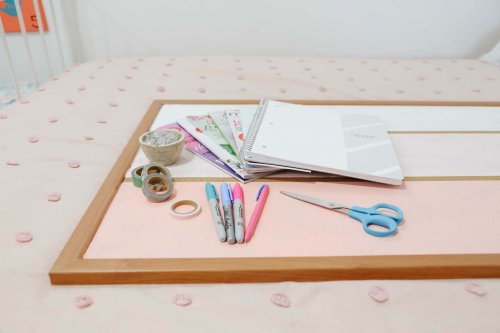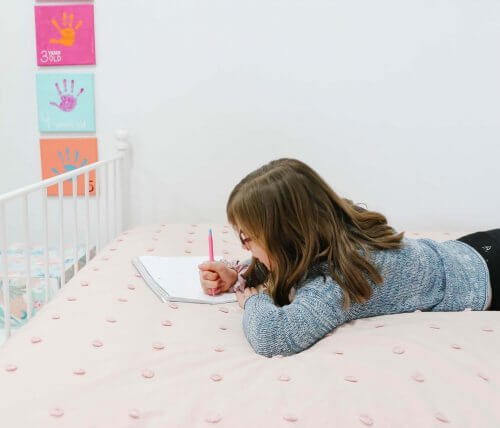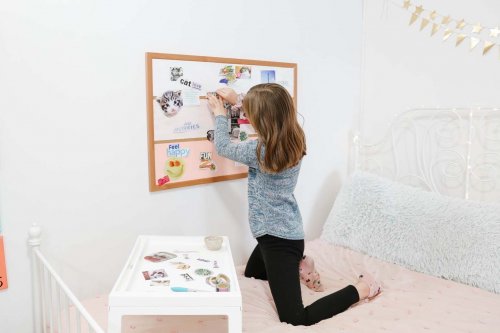What is a dream board? A dream board, also known as a vision board, is a collage of images, affirmations, and words that represent one’s goals—who they want to be, what they want to do, what they want to have in their life, among other things. They’re designed as a source of inspiration and motivation and can be a really powerful tool for both adults and children alike. For kids, dream boards can be a really positive and encouraging way to foster self-confidence as they serve as a source of inspiration and a regular reminder of their hopes and goals. Here’s how to make one with your child…
Step 1: Gather your supplies.
While dream boards are most often made using poster boards and glue, I really like using a cork board and tacks with kids as they allow for more flexibility and can easily be changed and rearranged. You’ll also need a variety of magazines and a pair of scissors, and markers, washi tape, a notebook, and a pen or pencil are optional, but recommended.

Step 2: Do a visualization.
As adults, we most often focus our vision boards on the coming year, but with children I like to open it up and focus on the future in general. Before beginning the visualization, talk about how the future can be next week, next year, or even when they’re an adult. Turn on some calm music and invite your child to get comfortable, close their eyes, and envision what they want their future to look like. You may want to gently prompt their visualization with some guiding questions.
Sample Guiding Questions
- What things do you want to do?
- Where do you want to be?
- What qualities do you want to have?
- How do you want to feel?
- Who do you want be with?
- What will you do for fun?
- What do you want to achieve?
- What do you want to do for work?
Step 3: Create a mind map.
While this step is optional, I find it really valuable when dreamboarding with kids. After the visualization exercise, take out a notebook and a pen or pencil and help your child jot down the key components they visualized for their future, using a mind map format. I like to place the title “My Future” in the centre and have categories like “Be”, “Do”, “Have”, and “Achieve” branching out from around it in order to give the child a starting point. This step helps solidify the visualization and serves as a guide when searching for images, words, and phrases to represent their dreams later.

Step 4: Find or create images, words, and phrases.
Something you’ll want to be mindful of here is that your magazine selection reflects your child’s interests and includes people who look like them. Invite your child to flip through the magazines to find images and text to represent their future dreams. As they go, they can use their mind map as a checklist in order to ensure that all of their ideas are represented. Encourage them to use paper, markers, and washi tape to create their own images, affirmations, and words in order to fill in any gaps or to add to the images they found.

Step 5: Create your dream board.
Ask your child to sort through their images and words and group them how they see fit. Next, help them play with placement and overlapping on their work surface to create mini layouts that are visually appealing to them. As they’re ready, have them tack their clippings and creations onto their cork board using the minimum number of tacks required. Encourage them to switch things up as needed, only fully tacking things down when everything is in place and they’re happy with how it looks.
Step 6: Display and discuss.
The final step! Find a spot to proudly display your child’s dream board. Somewhere where it’ll be easily seen each day is best as it will serve as a point of inspiration, motivation, and reflection. Sit with your child and soak it all in. Talk about their goals and dreams and together, come up with some actionable steps they can take in order to make their dreams become a reality. Encourage your child to spend some time with their dream board each day and to add to it or switch it up as they feel necessary (goals and dreams do sometimes change over time, after all!) And that’s it! In the following months, come back to the dream board with your child every now and then and continue to foster them using it as a tool and source of positive inspiration.
Jen Kossowan is a kindergarten and grade one teacher and mama of two gorgeous kiddos. She’s passionate about play, loves a good DIY project, and can most often be found in her kitchen whipping up recipes that taste delicious while meeting her crunchy mama criteria. She started Mama.Papa.Bubba. on a whim in 2010 while living in the Middle East and has been sharing her recipes and activities there ever since.
This article was published in The Good Life magazine.
